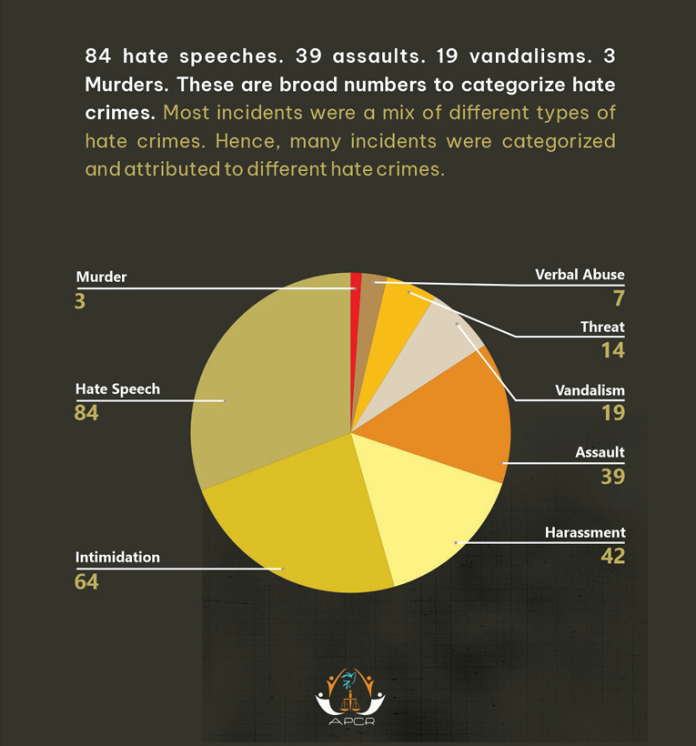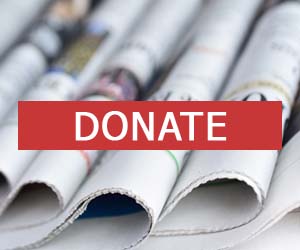– Dr. M. Iqbal Siddiqui
On April 22, 2025, a devastating terror attack in Pahalgam, Jammu and Kashmir, claimed 26 civilian lives, shattering the fragile calm of the valley and igniting a wave of national mourning. But the grief was short-lived. In its wake, an alarming surge of anti-Muslim and anti-Kashmiri violence swept across India. According to the Association for Protection of Civil Rights (APCR), 184 incidents of hate crimes were recorded between April 22 and May 8, affecting 316 victims. These were not random acts of mob frenzy, but rather the manifestation of deep-rooted communal fault lines, stoked by incendiary rhetoric, misinformation, and institutional indifference. Drawing on the APCR’s detailed Anti-Muslim Violence Post-Pahalgam report, this analysis explores the scale, nature, causes, and enduring impact of this hate wave – and calls for urgent moral and policy reckoning.
The Spark and Its National Fallout
The Pahalgam attack, carried out by unidentified militants, provoked nationwide outrage. While political leaders across the spectrum condemned the violence and security was beefed up in Kashmir, the public discourse took a sharp communal turn. Social media and partisan news channels swiftly labelled the attack “Islamic terrorism,” transforming collective mourning into collective scapegoating.
The APCR found that 106 of the 184 hate incidents directly cited the Pahalgam attack as justification. From Uttar Pradesh to Maharashtra, from university hostels to markets, Muslims and Kashmiris became soft targets in a climate that blurred the line between justice and vengeance.
Patterns and Geography of the Hate Wave
The APCR report provides a chilling statistical snapshot:
- Total Incidents: 184
o Hate speeches: 84
o Assaults: 39
o Vandalism: 19
o Murders: 3
o Intimidation: 64
o Harassment: 42
o Verbal abuse: 14
o Threats: 7
- Victims: 316
- States Affected: Uttar Pradesh topped the list, followed by Bihar, Maharashtra, Telangana, Delhi, and serious cases in Karnataka, Punjab, and West Bengal.
Notable incidents include:
- Murders:
o April 23, Agra: A Muslim man lynched by cow vigilantes (Incident 4).
o April 27, Mangaluru: A man beaten to death over an alleged “Pak slogan” (Incident 93).
o May 8, Bokaro: A Muslim man killed by a Hindu mob (Incident 182).
- Assaults and Intimidation:
o April 24, Santacruz, Maharashtra: A Muslim woman and her child assaulted by a Bajrang Dal-led mob chanting “Jai Shree Ram” (Incident 85).
o Hostels in Chandigarh and Himachal Pradesh were ransacked, targeting Kashmiri students (Incidents 6, 7).
- Vandalism and Arson:
o Muslim shops burned in Ambala (Incident 20).
o A mosque desecrated in Nainital (Incident 129).
- Hate Speech and Incitement:
o BJP’s Alok Sharma in Bhopal (Incident 130) and CM Pushkar Singh Dhami in Uttarakhand (Incident 9) delivered inflammatory speeches.
o Yati Narsinghanand and Praveen Togadia advocated for Muslim boycotts and expulsions (Incidents 11, 176).
o X posts and hashtags like #AllEyesOnPahalgam fanned hysteria (Incident 31).
The perpetrators were often affiliated with Hindutva organisations like Bajrang Dal and Vishwa Hindu Parishad. Police complicity was a recurring theme – Santacruz police refused FIRs against attackers but arrested victims instead (Incidents 87, 91).
Root Causes: More Than a Trigger
The Pahalgam massacre was a spark, but the fuel was long-prepared. The APCR identifies a toxic mix of:
- Immediate Triggers: Misinformation flooded social media, branding Muslims as “jihadis.” A fabricated narrative of “Muslim betrayal” framed the public psyche, inciting mob violence and justifying collective punishment.
- Political Rhetoric: The silence of high-ranking leaders and the incitement by regional politicians created an ecosystem of impunity. In Bhopal, Uttarakhand, and Jodhpur, political figures used dog whistles or outright inflammatory language to whip up emotions (Incidents 9, 16, 130, 113).
- Media Amplification: Several media outlets echoed these narratives uncritically, or worse, fuelled communal passions with provocative headlines and unverified claims. The distinction between journalism and propaganda eroded, further inflaming passions.
- Structural Fault Lines: Anti-Muslim sentiment has been steadily normalised in Indian politics and society, from the Citizenship Amendment Act (CAA) to recurring lynchings over cow protection. Decades of demonization have created fertile ground for hate to thrive, especially among economically frustrated youth.
Consequences: A Nation Fragmented
The toll of this hate wave is not limited to lives lost. It has shattered communal trust in countless localities, leading to deep psychological trauma. Mixed neighbourhoods now operate under suspicion. Muslim traders in Uttarakhand were boycotted, and Kashmiri shopkeepers in Dehradun faced calls for eviction (Post: @TheQuint, May 10).
Institutional apathy worsened matters. In Bareilly, a man driven to suicide after police harassment left a chilling message (Incident 135). Many FIRs went unregistered, perpetrators roamed free, and victims were often detained. The long-term risks are grave: the alienation of a minority, erosion of pluralism, and the risk of radicalisation as a defensive response to institutionalised bigotry.
A Climate of Collective Punishment: The Hate Wave’s Enduring Reach
The APCR’s report ends on May 8, 2025, but the hate wave’s shadow looms large to date, evolving into a chilling climate of collective punishment. While specific post-May 8 data is scarce, reports from mainstream media and X posts reveal a persistent surge in anti-Muslim and anti-Kashmiri hostility, targeting individuals, professionals, and entire communities with alarming consistency.
In Latur, Maharashtra, a Muslim man, labelled a “Pakistani,” was brutally assaulted and died by suicide, unable to endure the humiliation – a tragic echo of Bareilly’s earlier tragedy (Incident 135). In Dehradun, Kashmiri students were forcibly evicted from their hostel on May 10, left to sleep outside the airport, their only crime being their regional identity, mirroring earlier expulsions (Incident 120). In Mussoorie, Uttarakhand, Kashmiri shawl vendor Shabbir Dar and his assistant were attacked by locals on May 11, accused of representing “those responsible for Pahalgam” and warned never to return, a reprise of earlier vendor assaults (Incident 19).
The hate has even tainted institutions. In Madhya Pradesh, BJP minister Vijay Shah, though indirectly, called Colonel Sofiya Qureshi, a senior Indian Army officer, a “sister of terrorists” on May 9, prompting a rare judicial response: the Madhya Pradesh High Court ordered an FIR against him. However, his token apology underscores the impunity often afforded to such rhetoric. In Punjab’s Dera Bassi, Kashmiri students at the Universal Group of Institutes’ hostel faced attacks on May 12. In Shamli’s Toda village, Uttar Pradesh, Sarfaraz was assaulted by a man named Govind, who declared, “You have killed our 26; we will kill your 26!” – a sinister invocation of mob vengeance documented by Mithila Raut in Dainik Loksatta. In Haryana’s Kharawar village, Rohtak, Muslim families were threatened on May 13 to vacate or face repercussions, echoing earlier intimidation campaigns (Incident 105).
This relentless hostility, as Raut’s analysis notes, spans geographically from Uttar Pradesh to Karnataka, socially from students to soldiers, and institutionally from police inaction to political incitement. The hate wave, initially sparked by Pahalgam, has morphed into a narrative of collective punishment, vilifying Muslims and Kashmiris as perpetual outsiders. X posts, like @TheQuint’s May 14 report on Dehradun’s ongoing boycott campaigns, suggest this climate persists, unchecked by systemic intervention, threatening to normalise communal alienation.
Responses and the Road Ahead
The response to the hate wave has been uneven:
- Civil Society: The APCR’s documentation stands out as a rare act of courage and accountability. Interfaith groups and rights activists have led peace marches, but their reach remains limited.
- Government: No high-ranking political figure has unequivocally condemned the hate crimes. The arrests are few, the trials fewer, and the convictions virtually nil.
- Media: While some independent journalists and X users like @IAMCouncil have challenged hate speech and misinformation, mainstream outlets continue to sensationalise communal issues.
What India Needs Now:
- Enforceable hate crime laws with deterrent penalties.
- Media regulation to curb hate speech and ensure responsible reporting.
- Police reform to end complicity and improve victim protection.
- Interfaith dialogue platforms to rebuild trust at the grassroots.
- Economic and educational inclusion to address underlying frustrations.
Reclaiming India’s Pluralistic Soul: The Urgent Need for Action
The post-Pahalgam hate wave is a grim reminder of how easily grief can be converted into vengeance – and how swiftly a nation can turn against its own citizens. With 184 documented hate crimes and 316 victims, the APCR’s report offers more than just numbers; it presents a moral ledger of our times. Left unaddressed, such hatred will continue to corrode India’s constitutional soul. Silence is complicity. The moment to act is now – before another spark ignites another inferno.
[The writer is Assistant Secretary, Jamaat-e-Islami Hind.]




